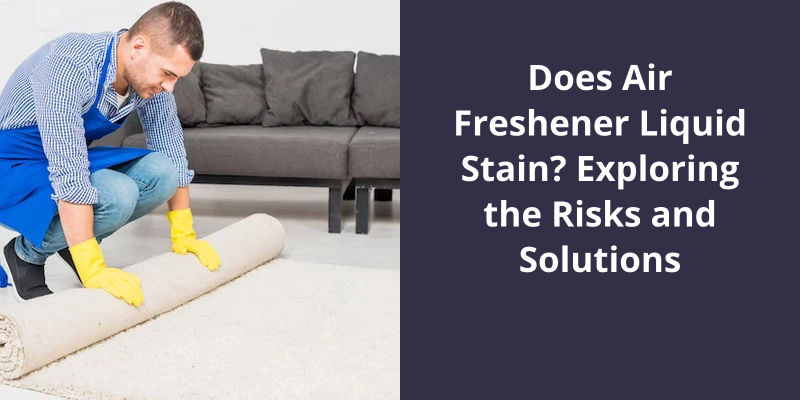Air fresheners have become an integral part of many households and public spaces. While they help in eliminating unpleasant odors and refresh the air, there have been concerns about whether air freshener liquids can cause staining on surfaces where they’re sprayed or spilled. This has led to questions on the compatibility of air freshener liquids with different surfaces, such as fabrics, upholstery, carpets, and floors. As a result, it’s essential to understand the possible effects that air freshener liquids can have on different surfaces to avoid any potential damage or discoloration. In this article, we will explore the question of whether air freshener liquids stain, and if so, what factors influence their ability to do so.

What Chemicals Are in Freshener?
Air fresheners have become increasingly popular in recent years, thanks to their ability to mask unpleasant odors and create a pleasant environment. However, many people may not be aware of the chemicals present in air fresheners, which can have harmful effects on their health. Air fresheners emit over 100 different chemicals, including volatile organic compounds and semi-volatile organic compounds that can cause irritations and respiratory problems.
Terpenes such as limonene, alpha-pinene, and beta-pinene, are among the most commonly used fragrances in air fresheners. These are naturally occurring compounds found in plants and fruits that have been shown to have both positive and negative effects on human health. While limonene, for example, has been found to reduce anxiety and depression in some studies, it can also trigger respiratory irritation and allergic reactions in sensitive individuals.
Phthalates are another common group of chemicals present in air fresheners. These are used to prolong the scent of the fragrance and can have a wide range of harmful effects on health. Exposure to phthalates has been linked to reproductive and developmental problems, as well as hormone disruption and increased risk of cancer. Women who’re pregnant or planning to conceive should be especially cautious about exposure to phthalates.
It’s important to take a closer look at the ingredients of the air fresheners we use in our homes, workplaces, and cars. While adsorbents, oxidizers, surfactants, and disinfectants are common components, there are other ingredients that can also be present. This includes fragrances, aerosol propellants, preservatives, and solvents like mineral oil and glycol ethers. Let’s explore these ingredients further to understand their potential impact on our health and the environment.
What Is Inside an Air Freshener?
Air fresheners are an essential element of our modern lifestyles. They can be found in homes, offices, cars, and public spaces. The primary purpose of an air freshener is to mask unpleasant odors and create a pleasant scent in any environment. However, the ingredients in an air freshener can vary depending on it’s intended use and the brand manufacturing it.
Aerosol propellants are also added to some types of air fresheners. These propellants ensure that the fragrance is evenly distributed throughout the environment. However, some types of aerosol propellants can be harmful to the environment and can also pose health risks if inhaled. Preservatives are also included in some air fresheners to help prolong their shelf life and maximize their effectiveness in eliminating odors.
Finally, solvents such as mineral oil or 2-butoxyethanol and other glycol ethers are added to air fresheners to help dissolve and distribute all of these ingredients throughout the product. Solvents can also have additional functions, such as serving as a cleaning agent. However, like aerosol propellants, some solvents can be harmful to the environment and toxic if inhaled, so it’s essential to choose air fresheners with safe and eco-friendly solvents.
These ingredients work together to eliminate odors and provide a pleasant scent in any environment. As a user, it’s important to read the ingredients label before using an air freshener to avoid any potential health or environmental risks.
Health Risks Associated With Air Fresheners and How to Choose Safer Options.
- Air fresheners can emit chemicals that can cause allergic reactions, respiratory irritation, and other health problems.
- To choose a safer option, look for air fresheners that are made from natural ingredients, such as essential oils or plant extracts.
- Avoid air fresheners that contain phthalates, formaldehyde, and other harmful chemicals.
- You can also try alternatives like opening windows, using natural fragrances like citrus peels or herbs, or using an air purifier.
- If you must use an air freshener, use it sparingly and in a well-ventilated area.
- Remember that the best way to improve indoor air quality is to reduce sources of pollution, such as tobacco smoke and chemicals from cleaning products.
Source: Air freshener – Wikipedia
While air fresheners may seem like a quick fix to get rid of unpleasant smells in your car, they don’t address the root cause of the problem. In fact, some people even question whether air fresheners can ruin the much-loved new car smell. Let’s explore this idea further and discover the truth behind the impact of air fresheners on your car’s scent.
Do Air Fresheners Ruin New Car Smell?
Using an air freshener to cover up the unpleasant odors in a new car is a temporary solution. Many car owners mistakenly believe that an air freshener will revive the fresh, new car smell, but in reality, this is just a myth. Air fresheners usually contain fragrances that are meant to mask unpleasant odors. However, they don’t eliminate the root cause of the problem.
If the odor is caused by mold or mildew, using air fresheners can make the problem worse. The moisture in the air freshener can actually promote the growth of mold and mildew, making the smell even more prominent.
Most often, the cause of unpleasant smells in a new car is the presence of volatile organic compounds (VOCs) that are released from the cars interior materials. These compounds can cause a variety of unpleasant odors, from a musty smell to a chemical smell.
To eliminate these odors, it’s important to clean your cars interior thoroughly. This means vacuuming the carpets and seats, wiping down the surfaces with a damp cloth, and using an upholstery cleaner to remove any stains. It’s also a good idea to use an air purifier to remove VOCs from the air.
For example, you can leave a bag of charcoal in the car to absorb odors. You can also use baking soda as a natural deodorizer. Simply sprinkle baking soda on the carpets and seats, let it sit for a few hours, and then vacuum it up.
They may mask the odor temporarily, but they don’t address the underlying cause of the problem. To truly get rid of musty, stale, or chemical smells, it’s important to identify the source of the problem and take steps to eliminate it. By cleaning your cars interior thoroughly and using natural deodorizers, you can keep your new car smelling fresh and clean for years to come.
While air fresheners may seem like a quick solution to mask underarm odors, it’s important to note that they’re not intended for that purpose. Instead, they should be used strictly for their intended purpose, which is to freshen the air in a room. In the following section, we’ll explore the potential dangers of using air fresheners on your skin and why it’s important to stick to using traditional deodorants for personal hygiene.
Can I Use Air Freshener as Deodorant?
Firstly, air fresheners are designed to do a different job than deodorant. While they may mask unwanted smells, they aren’t formulated with the same ingredients that target the bacteria that causes body odor. Air fresheners may temporarily hide the scent, but they won’t completely eliminate it like true deodorant.
While a lavender-scented air freshener may be a pleasant scent for a room, it may not work well underarm.
Fourthly, air fresheners aren’t designed to be sweat-proof. This could lead to embarrassing situations where body odor is still present despite using air freshener.
While they may seem like a quick fix in a pinch, it’s important to use products that are designed for the area in which they’re being used.
The Potential Dangers of Using Air Freshener as Deodorant, Including Skin Irritation and Respiratory Issues.
- Skin irritation
- Respiratory issues
- Potential allergic reactions
- Increased risk of asthma attacks
- Exposure to harmful chemicals
- Possible damage to nasal tissues
However, it’s important to be aware of the potential risks associated with overexposure to air fresheners. In this article, we’ll take a closer look at the effects of smelling too much air freshener and discuss steps you can take to reduce your risk of harm.
What Happens if You Smell Too Much Air Freshener?
However, excessive inhalation of air fresheners can lead to serious health problems. Some of the chemicals in air fresheners can cause irritation to the eyes, skin, and respiratory tract. Prolonged exposure to these chemicals can lead to coughing, shortness of breath, and wheezing. For people with pre-existing conditions such as asthma or allergies, exposure to air freshener chemicals can exacerbate their symptoms.
Another concern with air fresheners is their impact on the environment. Many air fresheners contain chemicals that can be harmful to wildlife and ecosystems. When air fresheners are used in enclosed spaces, such as cars or bathrooms, the chemicals can build up over time and create a toxic environment.
To avoid the negative effects of air fresheners, it’s recommended to use them in moderation and in well-ventilated areas. Consider using alternative methods of freshening the air, such as opening windows or using natural air purifiers like plants. Look for air fresheners made with natural ingredients and avoid those containing harsh chemicals and synthetic fragrances.
It’s important to be aware of the potential risks and to use these products in moderation. Alternatives that are safer for our health and the environment should also be considered. By being mindful of the products we use, we can create a healthier and more sustainable living environment for ourselves and those around us.
The Effects of Air Fresheners on Pets and Other Animals
- Air fresheners can cause respiratory distress in pets and animals
- The chemicals in air fresheners can be toxic to pets if ingested
- Pets with pre-existing respiratory conditions may be more susceptible to the negative effects of air fresheners
- Air fresheners can also trigger allergic reactions in pets, causing itchiness, sneezing, and other symptoms
- To avoid negative effects on pets and animals, consider using natural air fresheners such as essential oils or plants
- Always keep air fresheners out of reach of pets and animals
- If you suspect your pet has ingested or been exposed to air fresheners, seek veterinary attention immediately
Conclusion
Factors include the type and quality of the air freshener, the surface it’s applied to, and how long it’s left on the surface. It’s important to weigh the benefits of using air freshener versus the potential risks of staining before making a final decision. While there may not be a definitive answer, taking precautionary measures such as testing the air freshener on a small, inconspicuous area before use can help prevent any potential staining.




